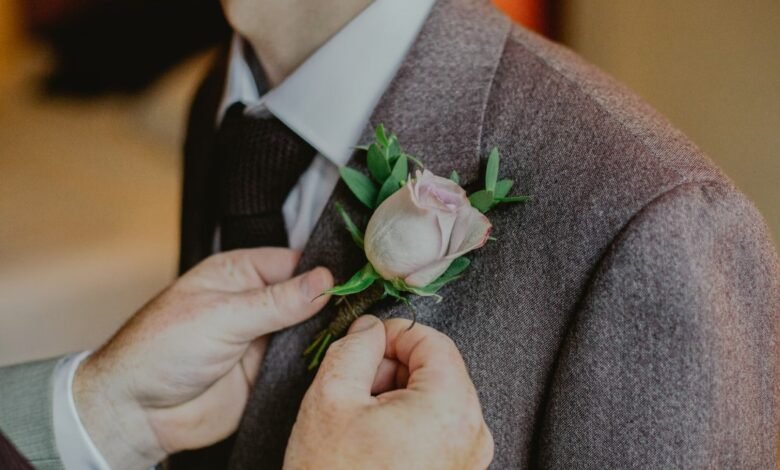The Ultimate Guide to Boutonniere: Styles, Tips, and Trends

Boutonniere are timeless accessories that add elegance and personality to formal attire. Whether for weddings, proms, or galas, these small floral arrangements hold significant symbolic and aesthetic value. In this comprehensive guide, we’ll explore the history of boutonnieres, popular styles, tips for choosing the perfect one, DIY steps, and current trends.
What Is a Boutonniere?
A boutonniere is a floral decoration worn on the lapel of a suit or tuxedo. Traditionally, it consists of a single bloom or a cluster of flowers, foliage, and accents. The term originates from the French word for “buttonhole,” reflecting its original placement through a lapel’s buttonhole.
The History of the Boutonniere
Boutonnieres date back to ancient civilizations, where warriors and nobles wore flowers for protection and status. In the Victorian era, they became symbols of romance, with specific flowers conveying hidden messages (e.g., red roses for love). Today, boutonnieres are staples at weddings and formal events, representing unity and refinement.
Types of Boutonnieres
Boutonnieres come in diverse styles to suit different occasions and preferences.
1. Classic Boutonnieres
Classic designs feature roses, carnations, or lilies. A single white rose or red carnation paired with greenery (e.g., eucalyptus) offers timeless sophistication.
2. Modern Boutonnieres
Contemporary styles incorporate succulents, dried flowers, or exotic blooms like orchids. Metallic accents (wire, beads) or unconventional materials (feathers, fabric) add a trendy twist.
3. Seasonal Boutonnieres
Match the season with flowers like sunflowers (summer), chrysanthemums (fall), holly berries (winter), or tulips (spring). Seasonal foliage (maple leaves, pine sprigs) enhances the theme.
4. Themed Boutonnieres
For themed weddings or events, boutonnieres can align with aesthetics like rustic (twine, burlap), bohemian (lavender, wildflowers), or coastal (seashells, succulents).
How to Choose the Perfect Boutonniere
Selecting the right boutonniere involves considering the event, attire, and personal style.
Consider the Occasion
- Weddings: Coordinate with the bouquet and wedding palette.
- Proms: Opt for bold colors or metallic accents.
- Corporate Events: Subtle designs (e.g., a single fern leaf) work best.
Match the Attire
Ensure the boutonniere complements the outfit’s color and style. For navy suits, try white blooms; for black tuxedos, red or burgundy adds contrast.
Reflect Personal Style
Minimalists may prefer a solitary bloom, while bold personalities can experiment with textures (berries, feathers) or vibrant hues.
Budget-Friendly Options
Use in-season flowers or DIY boutonnieres to save costs. Silk flowers are durable and affordable for long events.
DIY Boutonniere: Step-by-Step Guide
Create a custom boutonniere with these easy steps.
Materials Needed
- Fresh or faux flowers
- Floral wire and tape
- Ribbon or twine
- Scissors
- Pin or magnet
Step 1: Choose Your Blooms
Select a focal flower (e.g., rose) and accent greenery (eucalyptus, ivy).
Step 2: Trim and Arrange
Cut stems to 2–3 inches. Layer the focal flower with greenery and accents (baby’s breath, berries).
Step 3: Secure with Floral Tape
Wrap stems tightly with floral tape. Add ribbon for a polished finish.
Step 4: Attach a Pin
Fix a floral pin or magnet to the back for easy attachment.
Pro Tip: Spritz fresh boutonnieres with water and store in the fridge until the event.
Boutonniere Trends for 2023
Stay ahead with these trending styles:
1. Dried and Preserved Flowers
Eco-friendly dried blooms offer a vintage vibe and last longer.
2. Minimalist Designs
Tiny succulents, solitary buds, or even a sprig of herbs (rosemary) appeal to modern simplicity.
3. Bold Colors and Textures
Vibrant dahlias, velvet ribbons, or metallic leaves make statements.
4. Non-Floral Boutonnieres
Alternatives like fabric origami, brooches, or LEGO pieces cater to quirky tastes.
How to Care for Your Boutonniere
- Fresh Flowers: Store in the fridge, mist lightly, and avoid direct sunlight.
- Faux Flowers: Dust gently and store in a box to prevent damage.
FAQs
1. What’s the purpose of a boutonniere?
Boutonnieres add elegance to formal attire and symbolize honor (e.g., worn by grooms, VIPs).
2. How do I attach a boutonniere?
Pin it vertically on the left lapel, through the buttonhole if available.
3. Can boutonnieres be made without flowers?
Yes! Use feathers, fabric, or even small trinkets for a unique look.
4. How long do fresh boutonnieres last?
Fresh floral boutonnieres typically last 8–12 hours. Use hardy blooms like orchids for longevity.
5. Should the boutonniere match the bouquet?
Yes, coordinating colors and flowers creates a cohesive aesthetic for weddings.



